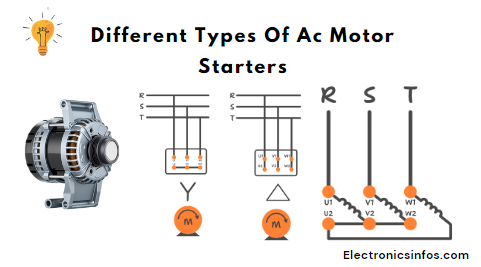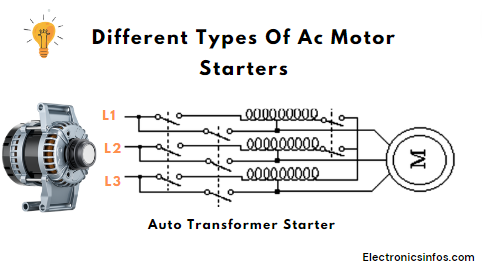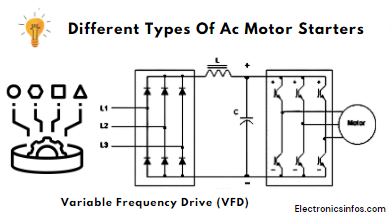What Are Electrical Motor's Starters?
 |
| Types of Motor starter |
AC motor starters are essential components in the electrical industry. It provides the necessary control and protection for motors during startup.
Motor starters include a switching mechanism in the form of a contactor, that controls the electrical connection to the motor. Motor starters are used to safeguard the motor from overheating due to excessive current.
Purpose of starter
- start the motor
- stop the motor
- reverse the motor direction
- protect the motor
- Control The speed of the Motor
- Controlled Starting behaviour
- Reduced Inrush Current
- Protection Against Overloading
- Prevention of Mechanical Stress
- Energy Efficiency
- Extended Motor Life
Why do We need a starter?
Starters are essential in electric motors, particularly in DC motors. They manage the initial surge current when the motor is turned on. Without a starter, the motor would draw an excessive amount of current, potentially four to six times its rated load current.
A starter mitigates this risk by introducing a variable series resistance into the motor's armature circuit, reducing the initial voltage across the winding. As the motor reaches its operating speed, the resistance is gradually decreased and eventually disconnected, allowing the motor to run normally.
For small DC motors that have a power of 1 horsepower or less, we use a simple method to directly start the motor. It works because the motor's winding resistance is enough to protect it. However, this method is only suitable for smaller size of motors.
Note
Remember when the motor begins to start it produces a Zero back EMF and when the motors start at their rated speed the back EMF is Maximum. so that's why we use starters to protect the motors.
Explanation
We know the armature current is found in the following formula- V = Supply Voltage,
- Eb= Back EMF,
- Ra =Armature Resistance,
For example, we have a 10 HP motor the armature resistance of this motor is 0.5 ohm
if we start this motor directly by 230 voltage the starting current is 460A which is 12 times higher as compared to the normal full load current. this high current destroys the brushes, commutators and armature windings. we designed the starting resistance such that it limits the current by 125 per cent to 200 per cent.
Types of Motor's Starters
- Direct-On-Line Magnetic Starter
- Rotor Resistance starter
- Auto Transformer starter
- Star -Delta Starter
- Manual Star -Delta Starter
- Semi-Automatic Star-Delta Starter
- Automatic Star-Delta Starter
- Direct-On-Line Magnetic Starter
Direct-On-Line Magnetic Starter
A Direct-On-Line (DOL) Magnetic Starter is used to start electric motors. It provides a full voltage start, connecting the motor directly to the power supply, which results in a high inrush current.
This type of starter is typically used for motors that do not require a reduced voltage start. The DOL starter consists of a contactor that switches the motor voltage, an overload relay that provides motor protection against overcurrent, and a control circuit that may include start and stop buttons.
Remember
we use manual DOL if the motor size is 5HP or below 7.5KW
we know that an induction motor draws a 5 to 7 times higher starting current as compared to their full load current. this starter is made in 3 phases normally. the equation for armature current in the motor.
Ia =V-Eb/Ra
The value of back emf (E) depends upon speed (N), E is directly proportional to N.
Since the DOL starter connects the motor directly to the main supply line, the motor draws a very high inrush current compared to the full load current of the motor (up to 5-8 times higher). The value of this large current decreases as the motor reaches its rated speed.
Parts of Manual DOL Magnetic Starter
- Magnetic Contactors
- On-Off Pushbuttons
- Thermal Overload relay
- Temperature Sensing device
- Current Sensing Device
- Temperature compensating Device
- trip contact device
- Resetting device
Parts of Automatic DOL Magnetic Starter
- Main contractors
- Contactors for star connection
- Contactors for Delta connection
- Timer
- Overload Relay
- Push Button (ON-OFF)
Advantages of Automatic DOL Magnetic Starter
- Simple operate and control
- economical starter
- full starting torque at the starting
- Easy to understand & troubleshoot
- Disadvantages
- DOL is suitable only for small motors.
- DOL Starter reduces the lifespan
- Mechanically tough
Rotor Resistance Starter
A rotor resistance starter is an electrical starting method used for three-phase induction motors. It involves inserting external resistors into the rotor circuit during the starting period. it reduces the starting current to better control the motor acceleration. The resistors are gradually shorted out as the motor accelerates, allowing it to operate at full speed.
 |
| rotor resistance starter |
This Starter consists of Variable Resistance which is connected in the form of a star connection. when we start the motor back emf is zero due to the static condition of the rotor, resistance is maximum in the rotor, when the rotor gains its rated speed it gradually decreases the resistance and when it's running at its rated speed all resistance will be removed in the circuit.
Advantages
- High starting torque
- Reduced starting current
- It improves the power factor
- Absence of line harmonics
- Disadvantages
- Lower efficiency
- just for slip ring induction motor.
- It needs daily maintenance
However, rotor resistance starters also have certain disadvantages
- high Power dissipation
- Mechanical wear and maintenance
- Limited speed control
- Increased complexity
Auto Transformer Starter
The Autotransformer Starter uses an autotransformer to reduce the voltage supplied to the motor during startup. This method limits the inrush current, making it suitable for starting larger motors smoothly and gradually.
The taps of the Auto Transformer used in the circuit are 60 -80 % to reduce the voltage for starting which tap is used depends upon the load. Autotransformer Starter can be used for both star/delta connections.
it may be noted that while the motor current varies with terminal voltage the line current drawn from the supply is further reduced by using an autotransformer. In an autotransformer, the line current is proportional to the square of the applied voltage.
Advantages
- Simple operation
- low power loss
- Easy to control and maintain
- Disadvantages
- It is used for lowering the starting torque
- There is a chance of sparking.
- Low power factor
Star Delta Starter
The Star-Delta Starter is designed for motors that need to start with a reduced voltage.

The star delta starter consists of three main components: the main contactor, the star contactor, and the delta contactor. It is designed to first connect the motor windings in a star configuration during the starting period and then switch to a delta configuration for normal running conditions.
The six terminals of motor winding are connected to the first in star connection, and when the motor has picked up the rated speed the connection is changed to the delta, which results in the voltage is 1/√3 times the normal voltage.
Advantages
- Automatic controlling system
- Low power loss
- simple and Smooth operation
- The starting current is reduced to one-third of the full load current.
- It minimizes the voltage drop in the electrical system during motor starting, reducing the impact on other connected loads.
- It helps prevent voltage dips and instability in the power supply system.
- It prevents excessive heating of the motor windings and reduces stress on the motor.
Disadvantages
- starting torque is low
- Six terminals are motor required.
- Reduced torque during starting
- Mechanical stress during the transition
- Complex wiring and control circuitry
- Limited applicability
- high Cost
Variable Frequency Drive (VFD)
A Variable Frequency Drive (VFD) is a motor starter that controls the speed of a motor by varying the frequency and voltage. One of the primary advantages of VFDs is their ability to reduce energy consumption.
VFDs allow for precise control of motor speed and torque that reduces the mechanical stress on motors during startup and shutdown.
Conclusion
Selecting the right AC motor starter is crucial for the optimal performance and protection of motors. Each type of starter has its unique advantages and is suited for specific applications.
Engineers and technicians must consider factors such as the size of the motor, the load characteristics, and the operational requirements when choosing a motor starter.
Frequently Asked Questions – FAQs
What are AC Motor Starters?
AC motor starters are devices used to control the starting, stopping, and sometimes the direction of an AC motor.
Why are different types of AC Motor Starters used?
Different starters are used to manage the inrush current when a motor starts, to protect the motor from damage, and to reduce stress on the electrical supply.
What are the common types of AC Motor Starters?
- Direct Online Starter (DOL)
- Star-Delta Starter
- Autotransformer Starter
- Soft Starter
- Variable Frequency Drive (VFD)
- Rotor-Resistance starter
- Multi-speed starter
How does a Direct Online Starter work?
A DOL starter connects the motor directly to the power supply, providing full voltage to the motor terminals.
What is a Star-Delta Starter?
A Star-Delta Starter initially connects the motor in a star configuration for starting, then switches to a delta configuration for running.
What is the purpose of a Soft Starter?
Soft Starters gradually increase the voltage to the motor, reducing the inrush current and mechanical stress on the motor.
When would you use an Autotransformer Starter?
An Autotransformer Starter is used when a lower starting current is required. It reduces the voltage supplied to the motor during start-up.
What advantages does a Variable Frequency Drive provide?
A VFD controls the speed of the motor by varying the frequency and voltage, providing precise speed control and energy savings.






-Electronicsinfos.png)

0 Comments
please do not insert spam links